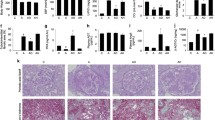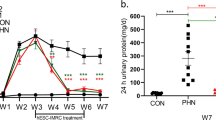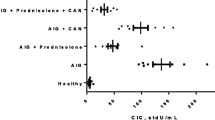Abstract
According to its immunopharmacological profile, 15-deoxyspergualin (15-DOS) has been investigated as to its disease-modifying activity on HgCl2-induced glomerulonephritis (GN) and on tubulointerstitial nephritis (TIN) in Brown-Norway rats. Both models are induced autoimmune disorders in which afflicted animals display high levels of serum autoantibodies directed against the glomerular or tubular basement membrane (GBM or TBM), respectively. The diseases are manifested by high serum creatinine and urea levels with severe proteinuria. In the model of HgCl2-GN, administration of 15-DOS clearly led to a reduction of proteinuria and decreased the amount of rat IgG attached to the GBM. Furthermore, a therapeutic effect could be demonstrated when 15-DOS was given after the appearance of clinical symptoms. Not only urine-protein values butalso anti-laminin antibodies returned to normal levels. Also in the experimental TIN-model, 15-DOS, either given during the induction phase, or even late in the onset of the disease, strongly prevented the proteinuria of this autoimmune disease and inhibited the formation of autoantibodies to TBN.
Similar content being viewed by others
References
H. U. Schorlemmer, G. Dickneite and F. R. Seiler,Treatment of acute rejection episodes and induction of tolerance in rat skin allotransplantation by 15-Deoxyspergualin. Transplant. Proc.22, 1626–1630 (1990).
H. U. Schorlemmer and F. R. Seiler,15-Deoxyspergualin (15-DOS) for therapy in an animal model of multiple sclerosis (MS): Disease modifying activity on acute and chronic relapsing experimental allergic encephalomyelitis (EAE). Agents and Actions34, 156–160 (1991).
H. U. Schorlemmer, R. R. Bartlett and F. R. Seiler,Curative effects of 15-Deoxyspergualin on murine systemic lupus erythematosus-like disease in MRL/l autoimmune mice. Int. J. Immunotherapy7, 169–180 (1991).
H. U. Schorlemmer, R. R. Bartlett, R. Schleyerbach and F. R. Seiler,Immunosuppressive activity of 15-Deoxyspergualin (15-DOS) on various models of rheumatoid arthritis. Drugs Exp. Clin. Res.17, 471–483 (1991).
N. Sato, K. Kamata and M. Okubo,Treatment of Heymann nephritis (HN) by 15-Deoxyspergualin. Kidney Int.33, 324–325 (1988).
P. G. Kerr, H. Y. Lan and R. C. Atkins,The effects of Deoxyspergualin on anti-GBM nephritis in rats. Kidney Int.38, 556–557 (1990).
C. Sapin, E. Druet, and P. Druet,Induction of antiglomerular basement membrane antibodies in the Brown-Norway rat by mercuric chloride. Clin. Exp. Immunol.28, 173–179 (1977).
G. H. Thoenes, T. Sitter, K. H. Langer, R. R. Bartlett and R. Schleyerbach,Leflunomide (HWA 486) inhibits experimental autoimmune tubulointerstitial nephritis in rats. Int. J. Immunopharmac.11, 921–929 (1989).
Author information
Authors and Affiliations
Rights and permissions
About this article
Cite this article
Schorlemmer, H.U., Neubauer, H.P., Czech, J. et al. Immunosuppressive therapy of organ-specific nephritic autoimmune diseases with 15-deoxyspergualin. Agents and Actions 39 (Suppl 1), C121–C124 (1993). https://doi.org/10.1007/BF01972741
Issue Date:
DOI: https://doi.org/10.1007/BF01972741




